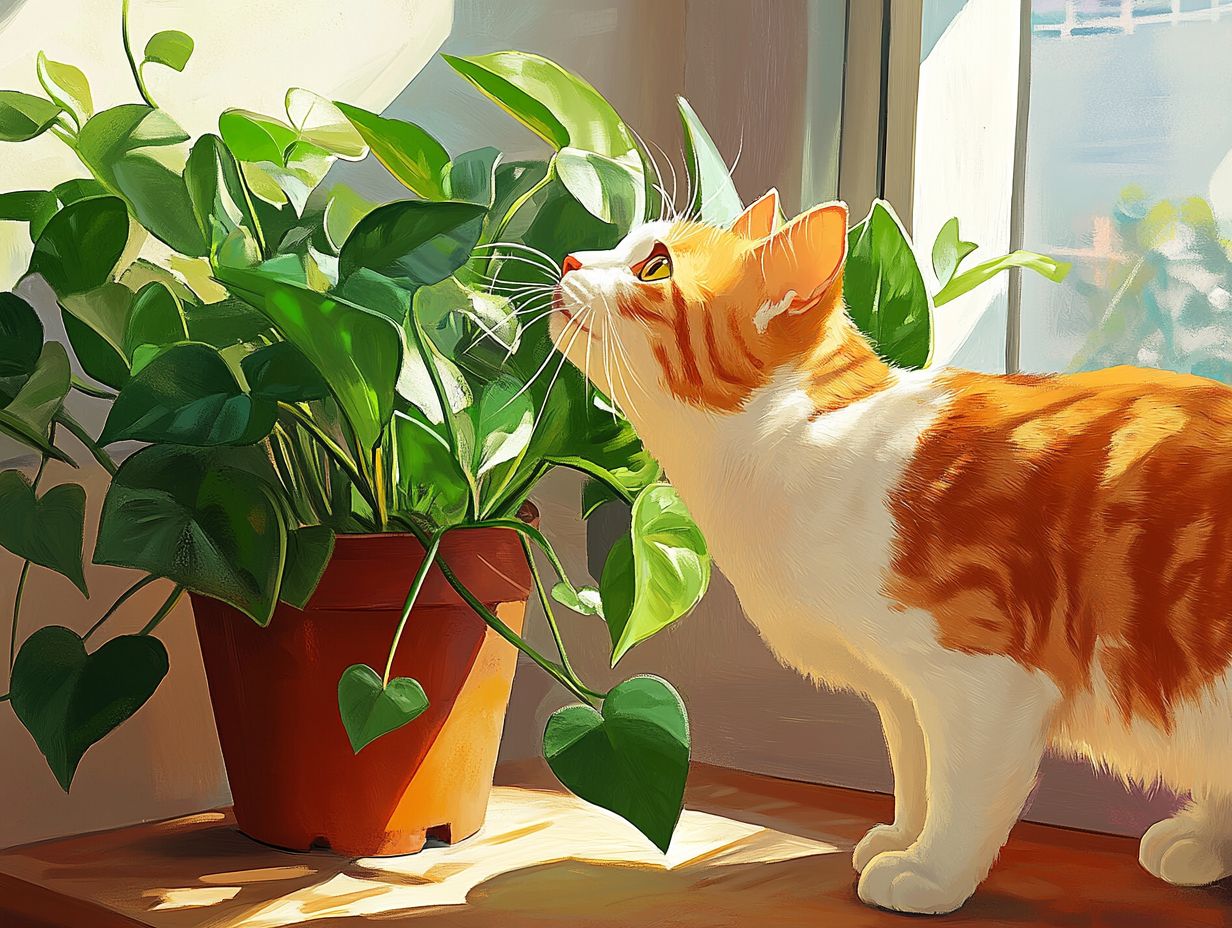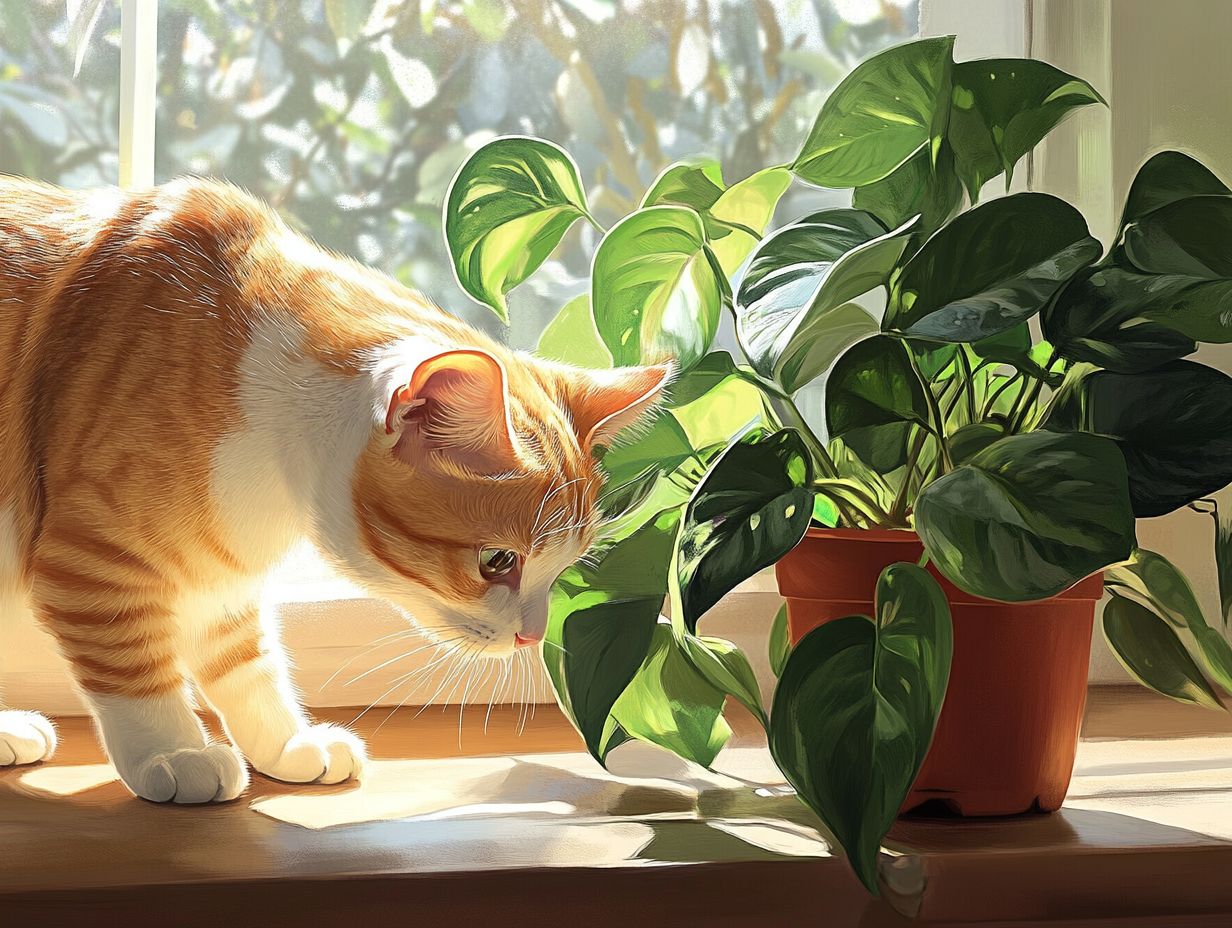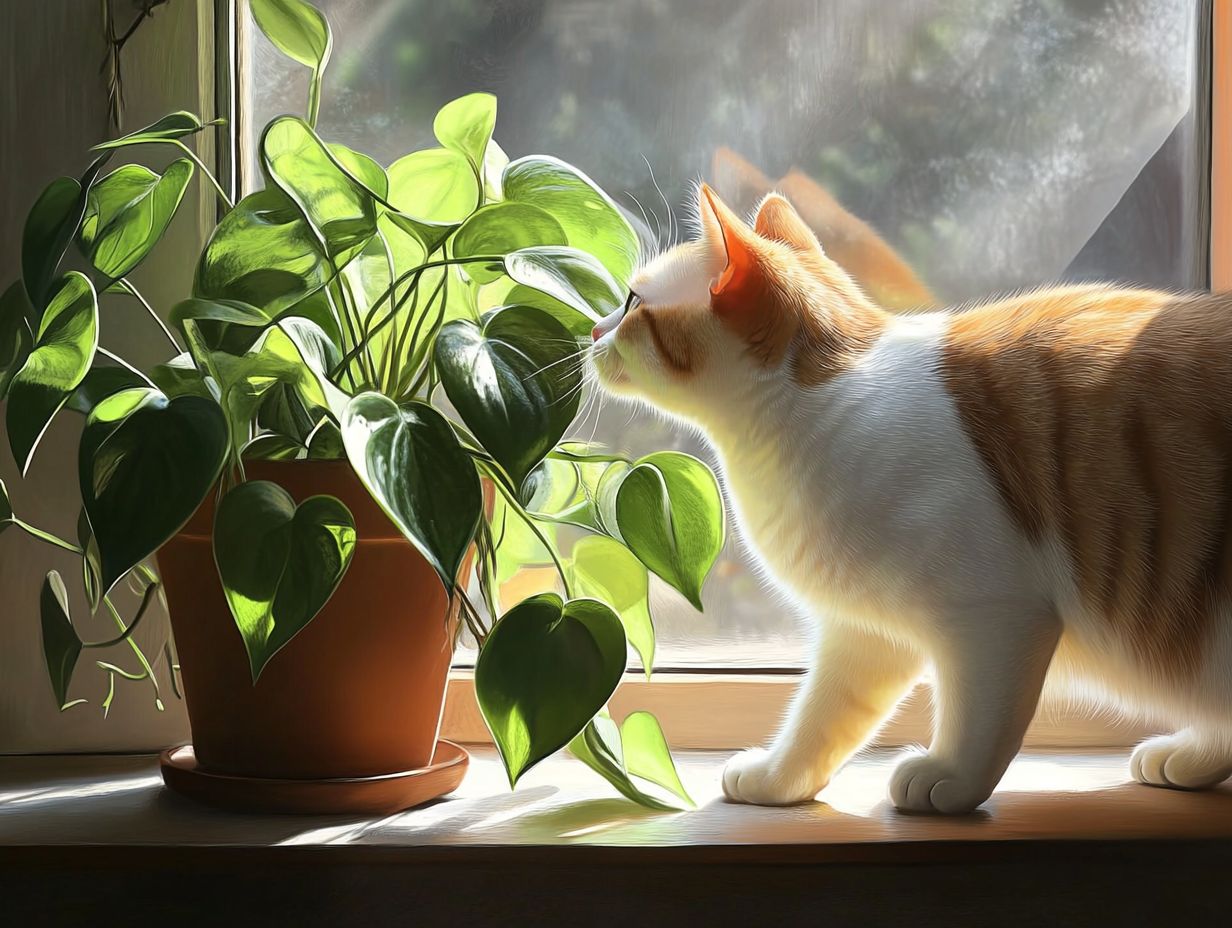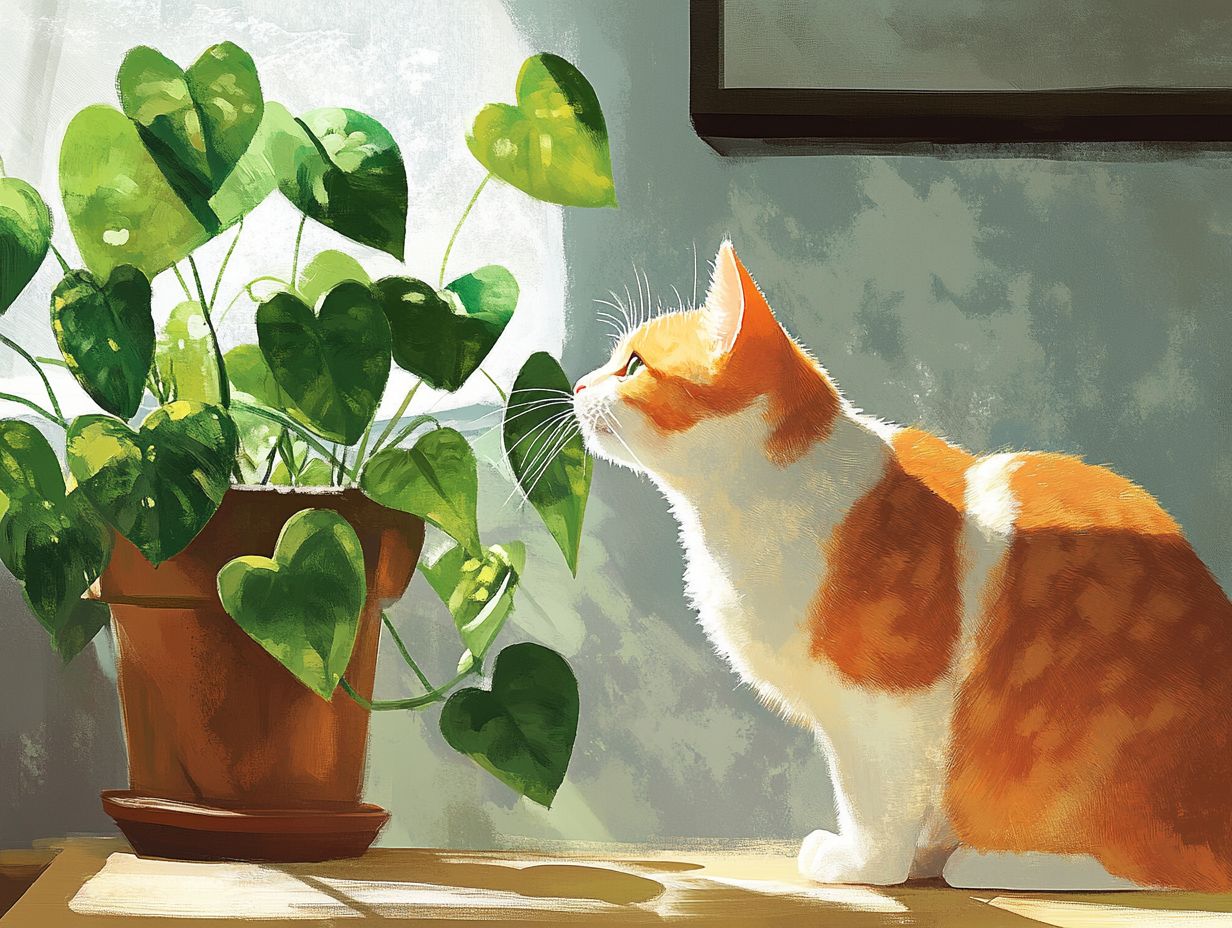Pothos plants, including the popular Golden Pothos and Marble Queen Pothos, are beloved for their lush foliage and easy-care reputation, making them a staple in many households. However, understanding the potential risks these popular houseplants pose to your furry friends is key to cat safety.
This article explores what pothos plants are, including their air-purifying qualities, why they’re appealing, and the dangers they may present to your cats. We also provide guidance on how to keep your pets safe while still enjoying beautiful indoor plants at home.
Key Takeaways:

- Pothos plants are popular houseplants because of their low maintenance, easy care, and air-purifying properties.
- Toxicity: Pothos plants are toxic to cats due to their presence of insoluble calcium oxalates, which can be harmful if ingested, leading to plant poisoning.
- Signs of Poisoning: Symptoms include drooling, vomiting, and difficulty breathing. If ingestion occurs, seek immediate veterinary care.
What Are Pothos Plants?
Pothos plants, commonly known as Devil’s Ivy or Golden Pothos, are among the most popular indoor plants due to their striking green leaves and air-purifying abilities.
Native to the Solomon Islands, these plants thrive in a variety of indoor conditions. They are highly tolerant of low light and irregular watering, making them an excellent choice for both beginner and experienced gardeners.
With long, trailing vines, Pothos can be easily trained to climb or can cascade elegantly from shelves and hanging baskets. Their remarkable ability to significantly improve indoor air quality contributes to their widespread popularity.
Why Are Pothos Plants Popular Houseplants?
Pothos plants are popular houseplants due to their attractive appearance and resilience, suitable for various indoor environments. The lush green vines enhance the greenery of homes and contribute to improved indoor air quality, a benefit that many plant owners appreciate.
These plants require minimal care, making them perfect for busy lifestyles or for those who are new to gardening, further increasing their appeal among homeowners and renters. Additionally, pothos can thrive in low-light conditions, which makes them a favored choice for a range of indoor settings, including apartments, offices, and residences.
Are Pothos Plants Safe for Cats?
Pothos plants are beautiful houseplants, but are they safe for cats? With their attractive foliage, Pothos can enhance the aesthetics of many homes.
However, the most crucial consideration for pet owners is whether these plants pose a threat to their feline companions. Pothos contain calcium oxalate crystals, which can be harmful to cats if ingested. Plant poisoning in cats may lead to symptoms such as excessive drooling, vomiting, and oral irritation. Source: ASPCA
Pet owners must weigh the beauty of these indoor plants against the potential risks to their cats. Note: Pothos plants are considered toxic to cats.
What Are the Toxic Components of Pothos Plants?

Calcium oxalate, the primary toxin found in the Pothos plant, can cause adverse reactions in pets, particularly in cats and dogs, when ingested. This compound is present in several household plants and can lead to symptoms categorized as follows:
- Mild Symptoms: Drooling, vomiting.
- Moderate Symptoms: Oral irritation, gastrointestinal upset.
- Severe Symptoms: Difficulty breathing, lethargy.
Calcium oxalate crystals irritate the mouth and throat, causing discomfort, which often results in cats becoming unwilling to eat or drink. The severity of symptoms can vary based on the amount ingested and the individual cat’s sensitivity. In some cases, symptoms similar to those of a jellyfish sting, such as lethargy or difficulty swallowing, may occur, causing distress for pet owners. Recognizing these symptoms early is crucial, as immediate veterinary intervention can alleviate suffering caused by these toxic effects and help prevent further complications, ensuring a swift recovery for the cat.
What Happens If a Cat Ingests Pothos Plants?
If you suspect your cat has ingested a pothos plant, follow these first aid steps:
- Rinse your cat’s mouth with water if safe to do so.
- Monitor for symptoms such as drooling or vomiting.
- Contact your veterinarian immediately for advice.
- Provide details about the incident, including the amount ingested.
First Aid and Treatment
To ensure your cat’s safety, act immediately if ingestion is suspected:
- Contact your veterinarian or a Pet Poison Control hotline for guidance.
- Monitor your cat for any signs of distress, such as drooling, vomiting, or lethargy.
- Collect any leftover plant material or packaging to provide to the vet.
- Stay calm and prepare for potential veterinary examination and treatment.
Prevention Tips
To keep pothos plants out of reach and ensure your pet’s safety:
- Place pothos plants on high shelves or in hanging baskets.
- Consider using barriers to prevent access to certain areas.
- Opt for alternative non-toxic plants, such as spider plants or Boston ferns.
Common Misconceptions
Many believe that pothos plants are safe if only a small amount is ingested. However, this is false; any ingestion can lead to toxicity.
Balanced Perspective
While pothos plants offer aesthetic appeal and air-purifying benefits, their toxicity should not be overlooked. Pet owners must consider both the beauty of these plants and the potential risks to their furry friends.
Special Considerations
Kittens and elderly cats may be more susceptible to the effects of toxins due to their smaller body size and differing health statuses.
Expert Input
Consult your veterinarian for personalized advice regarding the safety of houseplants in a household with pets. Disclaimer: This content is for informational purposes only and should not replace professional veterinary advice.
Emergency Contact Information
Emergency Contacts
For immediate assistance, contact:
- ASPCA Poison Control: 1-888-426-4435
Content Updates
This article was last reviewed on October 2023 and will be updated as new research becomes available.
Related Topics
For more information, check out our articles on toxic plants or general pet safety tips.
Toxicity Information and Symptoms
The Pothos plant is toxic to cats, primarily due to the presence of calcium oxalate crystals. All parts of the plant, including the leaves and stems, pose a risk to feline health.
Symptoms of Pothos plant poisoning in cats can be categorized by severity:
- Mild Symptoms: Drooling, vomiting, and oral irritation.
- Moderate Symptoms: Gastrointestinal pain, unusual scratching at the mouth, and decreased appetite.
- Severe Symptoms: Swollen tongue, difficulty swallowing, lethargy, dehydration (e.g., dry gums), and abnormal meowing or vocal distress.
If these symptoms are not addressed promptly, they can lead to further complications, including long-term health issues such as chronic gastrointestinal problems.
What Should I Do If My Cat Ingests Pothos Plants?
If you suspect that your cat has ingested Pothos plants, it is crucial to seek help immediately. Here’s a step-by-step first aid guide:
- Contact your veterinarian or a Pet Poison Control hotline for guidance.
- Monitor your cat for any signs of distress, such as drooling, vomiting, or lethargy.
- Collect any leftover plant material or packaging to provide to the vet.
- Stay calm and prepare for potential veterinary examination and treatment.
Acting quickly can significantly impact your cat’s recovery from plant poisoning.
Prevention Measures

To prevent your cat from eating Pothos plants, consider the following:
- Keep Pothos plants out of reach.
- Opt for pet-safe plants to create a safe indoor environment.
- Incorporate pet-safe alternatives, such as Boston Ferns and Spider Plants.
Understanding your cat’s behavior can help establish a safe space for both your plants and pets.
What Are Some Safe Alternatives to Pothos Plants for Cat-Friendly Houseplants?
Safe alternatives to Pothos plants for pet owners include:
- Boston Fern: Bushy foliage that thrives in humid environments and indirect sunlight.
- Spider Plant: Hardy and non-toxic, perfect for indoor settings.
- Christmas Cactus: Beautiful and safe for pets.
- Peperomia: Attractive and non-toxic option.
Creating a cat-friendly garden is achievable by selecting indoor plants that are non-toxic to cats.
What Plants Should I Avoid Having in My Home if I Have Cats?
The most crucial aspect of household safety for cats is understanding which plants are toxic to them in order to prevent poisoning. Many common household plants, such as Ivy Arum and Taro Vine, can be harmful to cats. For a comprehensive list, refer to the ASPCA’s toxic plant list.
It is essential to either keep these plants out of reach or avoid having them in your home altogether. Pet owners should be aware of toxic plants to minimize the risk of accidental ingestion and the associated health hazards, ensuring that their homes are safe for their feline companions. For more information, check out How Dangerous Are Pothos Plants for Cats? Signs and Symptoms to Watch.
What Are Some Common Houseplants That Are Toxic to Cats?
Many common houseplants can be dangerous for cats and should be avoided by pet owners to ensure their pets’ safety and health. In particular, several varieties from the Aroid family, including the Peace Lily, Philodendron, and Snake Plant, can cause uncomfortable symptoms such as vomiting, drooling, and difficulty swallowing if ingested.
Symptoms categorization:
- Mild: Drooling, mild stomach upset.
- Moderate: Vomiting, lethargy.
- Severe: Difficulty swallowing, potential organ damage.
It is essential for pet owners to be aware of these plants to reduce the risk of potential issues. Reliable sources, such as the ASPCA, provide extensive information, listing both toxic and non-toxic plants to help caregivers make informed choices.
By understanding these dangers, pet owners can keep their cats safe while creating beautiful indoor spaces filled with non-toxic plants.
If you suspect your cat has ingested a toxic plant, contact your veterinarian immediately. Provide them with information about the plant and follow their advice, which may include inducing vomiting.
Frequently Asked Questions

How dangerous are Pothos plants for cats?
Pothos plants are considered to be mildly toxic to cats. They contain calcium oxalate crystals, which can cause irritation and inflammation if ingested by cats. Source: ASPCA
What are the signs and symptoms to watch for if my cat has ingested Pothos plants?
The most common signs of Pothos plant ingestion in cats include drooling, vomiting, and difficulty swallowing. Your cat may also show signs of mouth and throat irritation.
How much Pothos plant does my cat need to ingest for it to be dangerous?
The amount of Pothos plant that can cause toxicity in cats varies depending on the individual cat. Some cats may experience symptoms after ingesting a small amount, while others may not show any symptoms unless they eat a larger quantity.
What should I do if I suspect my cat has eaten Pothos plants?
If you believe your cat has ingested Pothos plants, it’s important to seek veterinary care immediately. Your vet may recommend inducing vomiting to remove the plant from your cat’s system. Do not wait for symptoms to appear before seeking help.
Are there any long-term effects of Pothos plant ingestion in cats?
In most cases, there are no long-term effects of Pothos plant ingestion in cats. However, if a large amount is consumed, it can cause damage to the kidneys and other organs. It’s important to monitor your cat closely and seek veterinary care if necessary.
How can I prevent my cat from eating Pothos plants?
The best way to prevent your cat from eating Pothos plants is to keep them out of reach. Place them in areas that are not accessible to your cat, or consider using a plant stand or hanging them from the ceiling. You can also try using a bitter spray on the leaves to deter your cat from chewing on them. Additionally, consider safe plant alternatives like Areca Palm or Bamboo Palm.
Emergency contact for pet poison control: ASPCA Animal Poison Control Hotline.
Last review date: October 2023. This content is regularly updated based on new research.
Disclaimer: This article is for informational purposes only and should not replace professional veterinary care. Always consult your veterinarian for personalized advice.